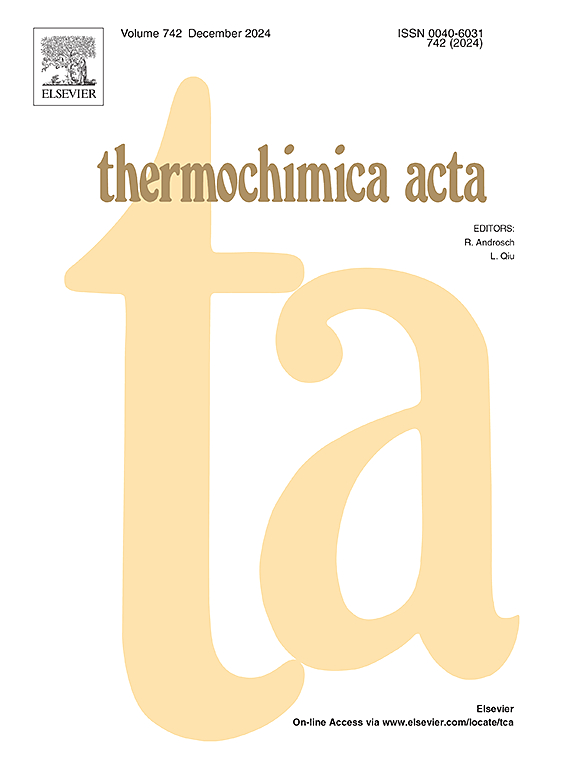A novel phosphoryl imidazolate flame retardant for polyester-cotton blend fabrics: Flame retardancy, thermal behavior and mechanical properties
IF 3.1
2区 化学
Q2 CHEMISTRY, ANALYTICAL
引用次数: 0
Abstract
Inspired by the disperse dye in thermosol dyeing for polyester and polyester- containing fabrics, a novel small-molecule phosphoryl imidazolate compound with phosphorus, nitrogen, and heterocyclic aromatic structure, 2-(1H-imidazol-1-yl)-5,5-dimethyl-1,3,2-dioxaphosphinane-2-oxide (DOPIM), was successfully synthesized and utilized to enhance the flame retardancy of polyester-cotton blend (PTCO) fabrics through a convenient dip-dry-cure (PDC) strategy. The FTIR and NMR were employed to detect the chemical structure of DOPIM. Furthermore, to investigate the enhancement of PTCO's flame retardancy by integration of DOPIM, the thermal stability, flammability, combustion behavior and physical properties of the samples were comprehensively assessed. The char residues of the treated PTCO in the nitrogen atmosphere increased to 12.86 % from 2.90 % of the PTCO at 700 °C. The DOPIM treated PTCO exhibited a LOI of 28.7 % and exceptional self-extinguishing performance, with a damage length of 36 mm. The PHRR and THR of the DOPIM-treated PTCO decreased by 33 % and 32 %. TG, CCT and TG-FTIR analysis of PTCO, along with other test results demonstrated that DOPIM not only facilitated the degradation and char formation of cotton fibers, reducing their flammability, but also significantly reduced the degradation rate of polyester fibers. The presence of char and nonflammable gases generated from both the cotton and DOPIM contributed to form a stable char in PTCO. This indicates that DOPIM effectively worked for both cotton and polyester, enhancing the overall fire resistance of the PTCO. Notably, the DOPIM had no significant negative effect on the mechanical properties, handle and whiteness of the PTCO. In summary, this work offered a convenient and effective method for fabricated fire-safety PTCO, which holds significant importance in safeguarding life and property.
一种新型咪唑磷基涤棉混纺织物阻燃剂:阻燃性能、热性能和力学性能
受涤纶及含涤纶织物热溶胶染色中分散染料的启发,成功合成了一种新型的具有磷、氮和杂环芳烃结构的小分子磷酰咪唑酯化合物2-(1h -咪唑-1-基)-5,5-二甲基-1,3,2-二氧膦烷-2-氧化物(DOPIM),并通过方便的浸干固化(PDC)策略用于增强涤棉混纺(PTCO)织物的阻燃性。利用傅里叶变换红外光谱(FTIR)和核磁共振(NMR)对DOPIM的化学结构进行了表征。此外,为了研究DOPIM对PTCO阻燃性能的增强作用,对样品的热稳定性、可燃性、燃烧性能和物理性能进行了综合评价。处理后的PTCO在氮气气氛中的焦渣残留量由700℃时的2.90%增加到12.86%。DOPIM处理的PTCO具有28.7%的LOI和出色的自熄性能,损伤长度为36 mm。经dopim处理的PTCO的PHRR和THR分别下降33%和32%。PTCO的TG、CCT和TG- ftir分析以及其他测试结果表明,DOPIM不仅促进了棉纤维的降解和成焦,降低了棉纤维的可燃性,而且显著降低了聚酯纤维的降解率。焦炭和棉花和DOPIM产生的不可燃气体的存在有助于在PTCO中形成稳定的焦炭。这表明DOPIM对棉和涤纶都有效,提高了PTCO的整体防火性能。值得注意的是,DOPIM对PTCO的力学性能、手感和白度没有显著的负面影响。总之,本工作为制备防火安全PTCO提供了一种方便有效的方法,对保障生命财产安全具有重要意义。
本文章由计算机程序翻译,如有差异,请以英文原文为准。
求助全文
约1分钟内获得全文
求助全文
来源期刊

Thermochimica Acta
化学-分析化学
CiteScore
6.50
自引率
8.60%
发文量
210
审稿时长
40 days
期刊介绍:
Thermochimica Acta publishes original research contributions covering all aspects of thermoanalytical and calorimetric methods and their application to experimental chemistry, physics, biology and engineering. The journal aims to span the whole range from fundamental research to practical application.
The journal focuses on the research that advances physical and analytical science of thermal phenomena. Therefore, the manuscripts are expected to provide important insights into the thermal phenomena studied or to propose significant improvements of analytical or computational techniques employed in thermal studies. Manuscripts that report the results of routine thermal measurements are not suitable for publication in Thermochimica Acta.
The journal particularly welcomes papers from newly emerging areas as well as from the traditional strength areas:
- New and improved instrumentation and methods
- Thermal properties and behavior of materials
- Kinetics of thermally stimulated processes
 求助内容:
求助内容: 应助结果提醒方式:
应助结果提醒方式:


